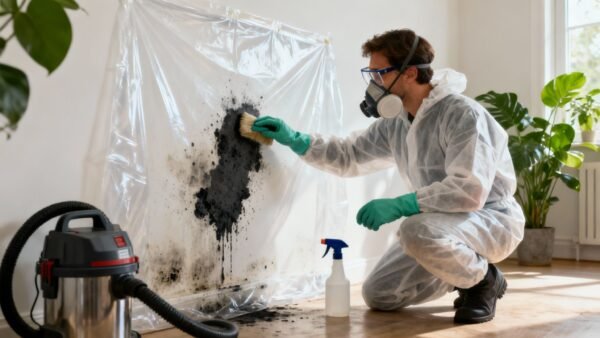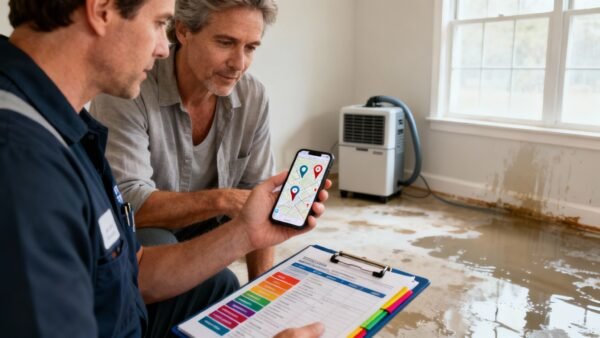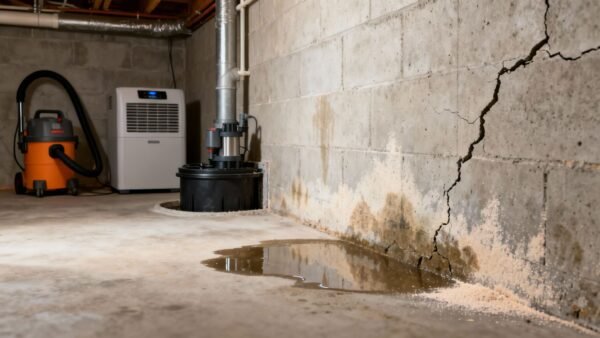Discovering mold in your Los Angeles home is stressful enough without the added worry of a surprise bill. The first question on every homeowner’s mind is, how much is this going to cost me? Using a mold removal cost calculator is a great first step, but understanding what drives those numbers is key.
While every mold problem has its own quirks, most homeowners in areas like the San Fernando Valley or the Westside find themselves paying somewhere between $1,500 and $6,000 for professional remediation. But that’s a huge range. This guide will walk you through what actually drives that cost, so you can get a much clearer picture of what to expect for your specific situation.
Your Guide to Estimating Mold Removal Costs in LA

Getting a handle on the potential cost of mold remediation is the first real step toward taking back your home. Guessing games just pile on more anxiety, so let’s skip that. By looking at the key variables—from a small patch in a Santa Monica bathroom affected by coastal fog to a larger issue from a flat-roof leak in Sherman Oaks—you can move from wondering to planning.
The final price tag really boils down to a few critical factors. These are the details that separate a minor weekend cleanup from a major restoration project.
Key Factors Influencing Your Estimate
Let’s break down the three biggest things that will move the needle on your estimate:
- Size of the Infestation: This is the big one. The total square footage of mold growth is the primary driver of cost. A small, contained spot of mold in a bathroom corner is a completely different ballgame than a basement wall covered in it after winter rains.
- Location and Accessibility: Where is the mold hiding? If it’s out in the open, that’s one thing. But mold lurking behind drywall, tucked away in a tight crawlspace, or growing inside your HVAC ducts requires a lot more labor, specialized tools, and time to get to.
- Extent of Damage: Mold and moisture are a package deal. If the root cause was a busted pipe or a leaky roof, the project costs will swell. You’re not just paying for mold removal; you’re also paying to fix the water damage that invited it in. For a deeper dive on that, our guide on water damage cleanup costs is a great resource.
The national average for mold removal hovers around $2,365, but honestly, that number can be deceiving for Los Angeles properties. I’ve seen minor jobs wrap up for as little as $375. On the flip side, severe infestations involving structural repairs or toxic black mold can easily climb past $7,000.
To give you a better starting point, here’s a quick look at how project size typically translates into cost.
Estimated Mold Removal Costs by Project Size
| Affected Area (Square Feet) | Typical Cost Range | Common Scenario |
|---|---|---|
| Small (Under 10 sq. ft.) | $500 – $1,500 | A contained patch of mold in a bathroom or under a kitchen sink. |
| Medium (10-100 sq. ft.) | $1,500 – $4,000 | Mold growth in a crawlspace or a section of a damp basement. |
| Large (Over 100 sq. ft.) | $4,000 – $7,000+ | Widespread mold after a flood or affecting an entire attic. |
These ranges are a solid baseline, but remember that the factors we discussed—location and damage—can push your final cost to the higher or lower end of these estimates.
Key Takeaway: The price isn’t just for scrubbing what you can see. A proper job involves setting up containment zones, running air scrubbers, safely removing contaminated materials, and, most importantly, fixing the moisture issue so the mold doesn’t come right back.
When you understand what goes into the process, you can have a much more informed conversation with remediation pros and feel confident you’re getting a fair quote.
The Four Factors Driving Your Remediation Bill
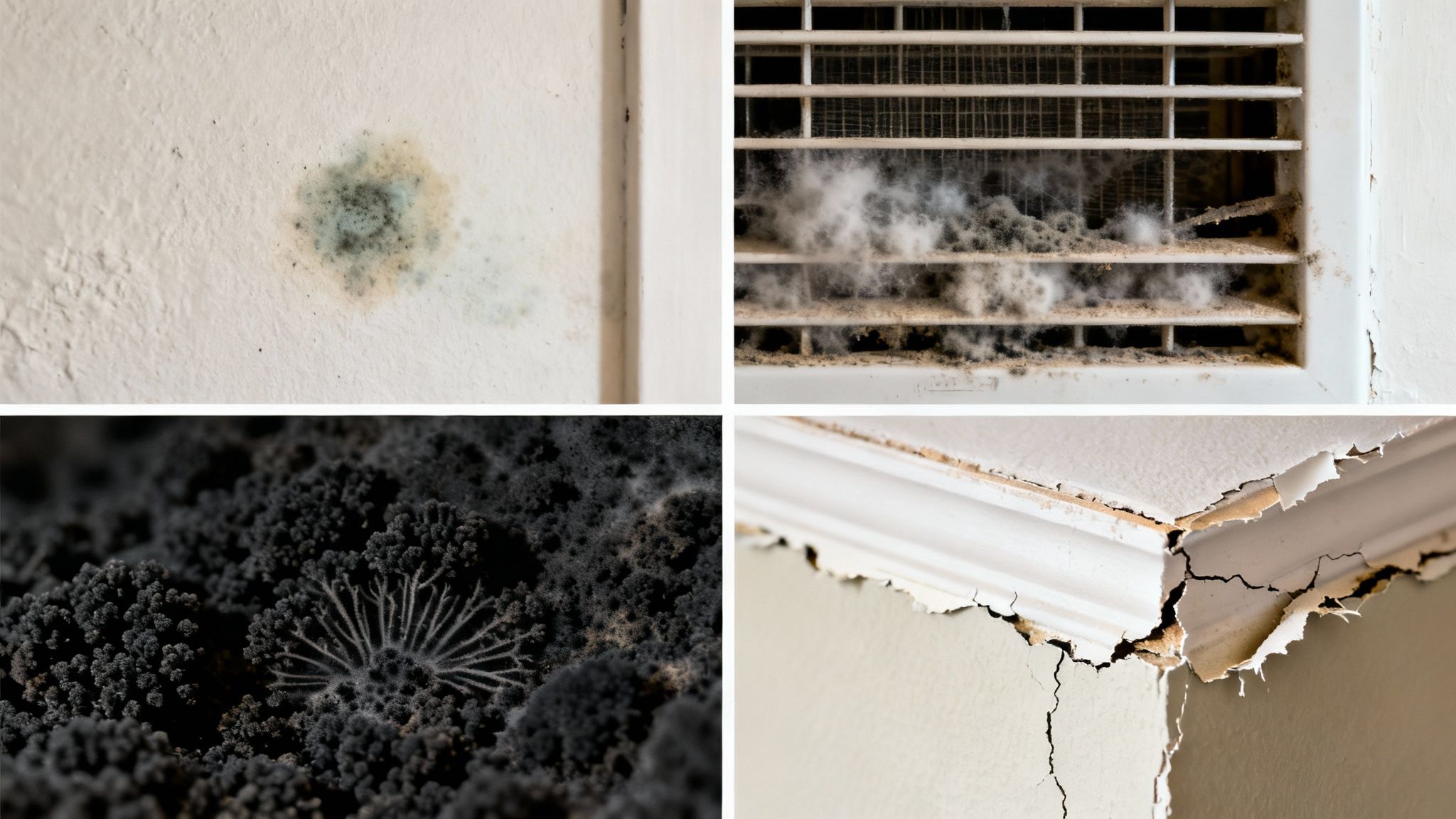
If you’ve ever gotten a few mold removal quotes, you know the numbers can be all over the map. One estimate might come in around $500, while another shoots past $5,000. So, what gives? The final price tag isn’t arbitrary; it boils down to four key variables.
Getting a handle on these cost drivers is crucial. It helps you make sense of the estimates you receive, ask smarter questions, and get a more accurate number when using a mold removal cost calculator.
Size of the Infestation
This is the big one. The total square footage of the mold problem is, without a doubt, the most significant factor influencing your bill. Think about it: a tiny, 10-square-foot patch of surface mold in a wide-open basement is a relatively quick fix.
Compare that to an entire attic covered in mold because of bad ventilation. That’s a whole different beast—a much bigger, more complex, and more expensive job. Most remediation work is priced per square foot, so the math is simple: more mold equals a higher cost.
Location and Accessibility
Where the mold is hiding is just as important as how much of it there is. Mold growing on an easy-to-reach concrete wall in your garage? Not a huge deal. But when it’s tucked away in tricky spots, the price starts to climb.
Accessibility issues dramatically increase the labor and complexity involved.
- Behind Drywall: This isn’t just about cleaning. It means carefully cutting out sections of the wall, treating the cavity behind it, and then putting it all back together.
- In an HVAC System: This is a highly technical job. Professionals have to clean the ducts, air handlers, and coils to make sure spores aren’t just getting blown all over your house.
- In a Cramped Crawlspace: Working in tight, confined areas takes more time, specialized gear, and a lot more effort, which directly impacts labor costs.
Type of Mold
Let’s be clear: all mold needs to go. That said, some types of mold demand more intensive safety measures and disposal techniques, which bumps up the price. Common household molds like Cladosporium are usually less complicated to deal with than toxigenic species like Stachybotrys chartarum, better known as black mold.
When technicians encounter potentially hazardous mold, the game changes. They need advanced personal protective equipment (PPE), have to set up critical containment barriers, and often use negative air pressure machines to keep spores from escaping. These safety protocols are non-negotiable for protecting the crew and your family, but they do add to the project’s bottom line.
The specific mold remediation service you’ll need is directly tied to what kind of mold is identified during the initial inspection.
Extent of Underlying Damage
Finally, and this is a big one that people often overlook, mold is just a symptom. The real culprit is always a moisture problem. The cost isn’t just about scrubbing away the mold you see; it’s about fixing the water source and repairing whatever damage it left behind.
A quick fix, like re-caulking a leaky window, won’t add much to the budget. But what if the mold grew because of a cracked foundation, a leaky roof, or a pipe that burst inside a wall? Now the scope of the project has expanded dramatically.
These foundational repairs are absolutely essential for a permanent solution. In many cases, the cost of fixing the water issue and the resulting damage can actually be much higher than the cost of the mold cleanup itself. Looking at all four of these factors together is the only way to get a realistic financial picture for your project.
How Our Mold Removal Cost Calculator Works
We built our mold removal cost calculator to cut through the confusion and give you a realistic budget baseline. It’s not just a simple numbers game. Think of it as a practical tool that translates your specific situation into a solid cost estimate, so you can plan your next steps with confidence.
Getting a reliable result all comes down to the information you put in. The calculator works by analyzing the key factors that drive the scope, and therefore the cost, of a professional remediation job. Each piece of data you provide helps build a clearer financial picture, like assembling a puzzle.
Gathering the Right Information for an Accurate Estimate
First things first, you need to know the size of the affected area. This is the single biggest factor. Grab a tape measure and figure out the approximate square footage of the visible mold. For instance, if you’ve got a patch on the wall that’s about 5 feet wide and 10 feet tall, you’re looking at a 50-square-foot problem.
Next, you’ll need to identify the materials affected. There’s a world of difference between mold on a hard, non-porous surface like bathroom tile and mold that has soaked into porous materials like drywall, insulation, or carpeting. Different materials demand different removal techniques, which the calculator accounts for.
Finally, try to pinpoint the moisture source. Was this a one-time event, like a burst pipe? Or is it from a chronic issue, like persistent high humidity in a poorly ventilated basement? This detail helps the calculator factor in any associated water damage repair needs that often go hand-in-hand with mold.
This infographic outlines the steps in our mold remediation cost calculator.
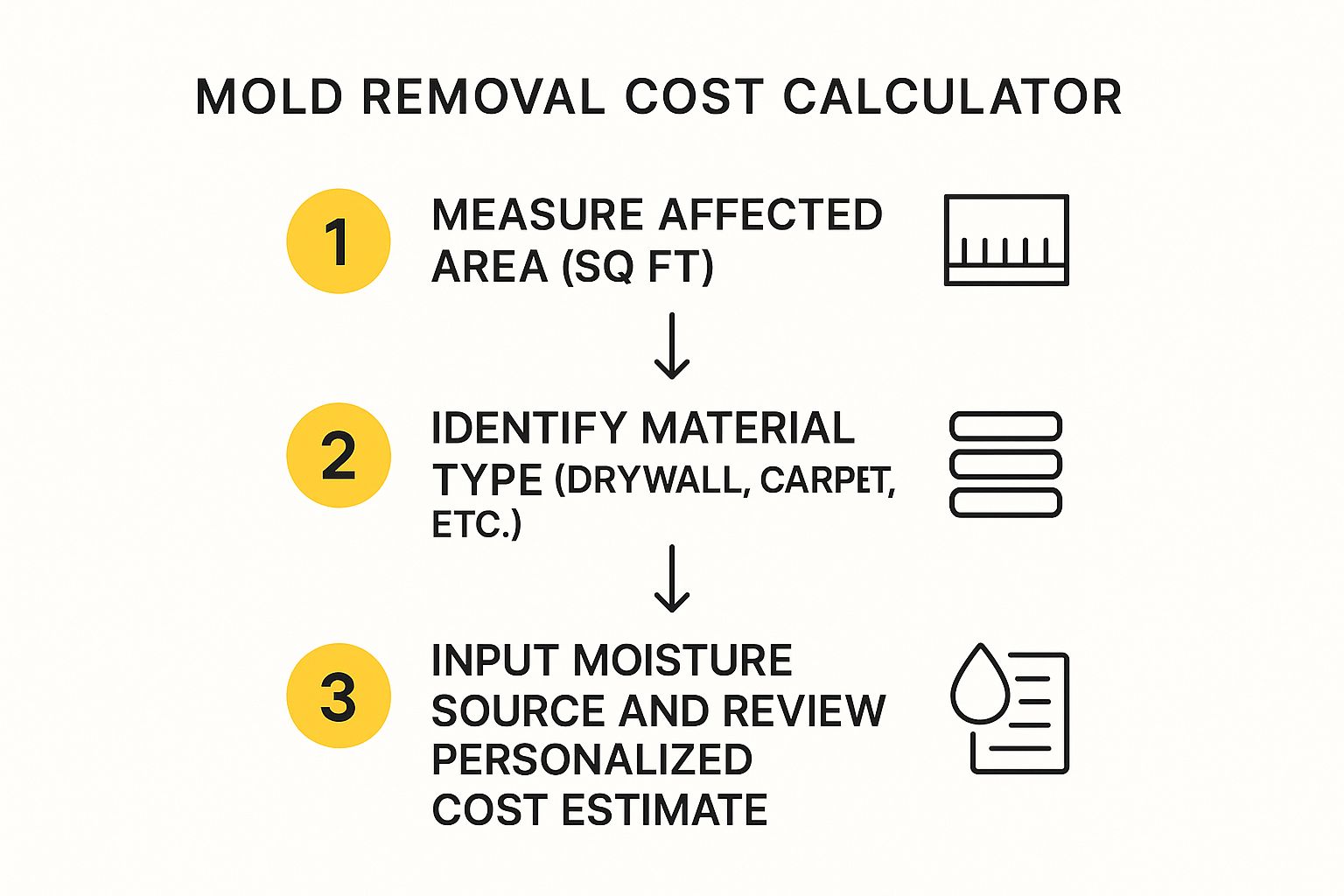
As you can see, it’s a straightforward flow designed to get you from measurement to a personalized estimate as quickly as possible.
Interpreting Your Personalized Estimate
Let’s walk through a common, real-world scenario. You find that 50-square-foot patch of mold on your bathroom drywall, and you’ve traced it back to a slow, persistent leak from a plumbing fixture.
Here’s what you would input:
- Area: 50 sq ft
- Material: Drywall
- Moisture Source: Slow Leak / Plumbing
Once you plug that in, the calculator will process the information and generate an estimated cost range. Nationally, mold remediation costs tend to fall somewhere between $15 and $30 per square foot, depending on how severe the problem is. For smaller jobs (10–100 sq ft), this often means a total cost between $500 and $1,500. Of course, extensive projects can easily climb past $6,000.
Important Note: The estimate our calculator gives you typically covers the core remediation work: containment, air filtration, safe removal of contaminated materials, and antimicrobial treatments. It generally does not include the cost of fixing the original moisture source or the reconstruction work, like replacing drywall, flooring, or repainting.
This initial number is an incredibly powerful tool for budgeting. But it’s crucial to remember that a calculator gives you an estimate, not a final quote. For a precise figure, nothing beats a professional inspection to uncover any hidden mold and assess the full scope of the job.
If you smell that musty odor but can’t see any visible signs, you might want to consider professional mold testing services to confirm its presence before you start planning for remediation.
DIY Cleaning vs. Professional Mold Remediation
So you’ve found mold. The immediate, and very natural, question is, “Can I just clean this up myself?” Honestly, sometimes you can. But knowing when to grab a bottle of cleaner versus when to call in the pros is the most important decision you’ll make. Getting it wrong can cost you a lot more down the road, both in money and in your health.
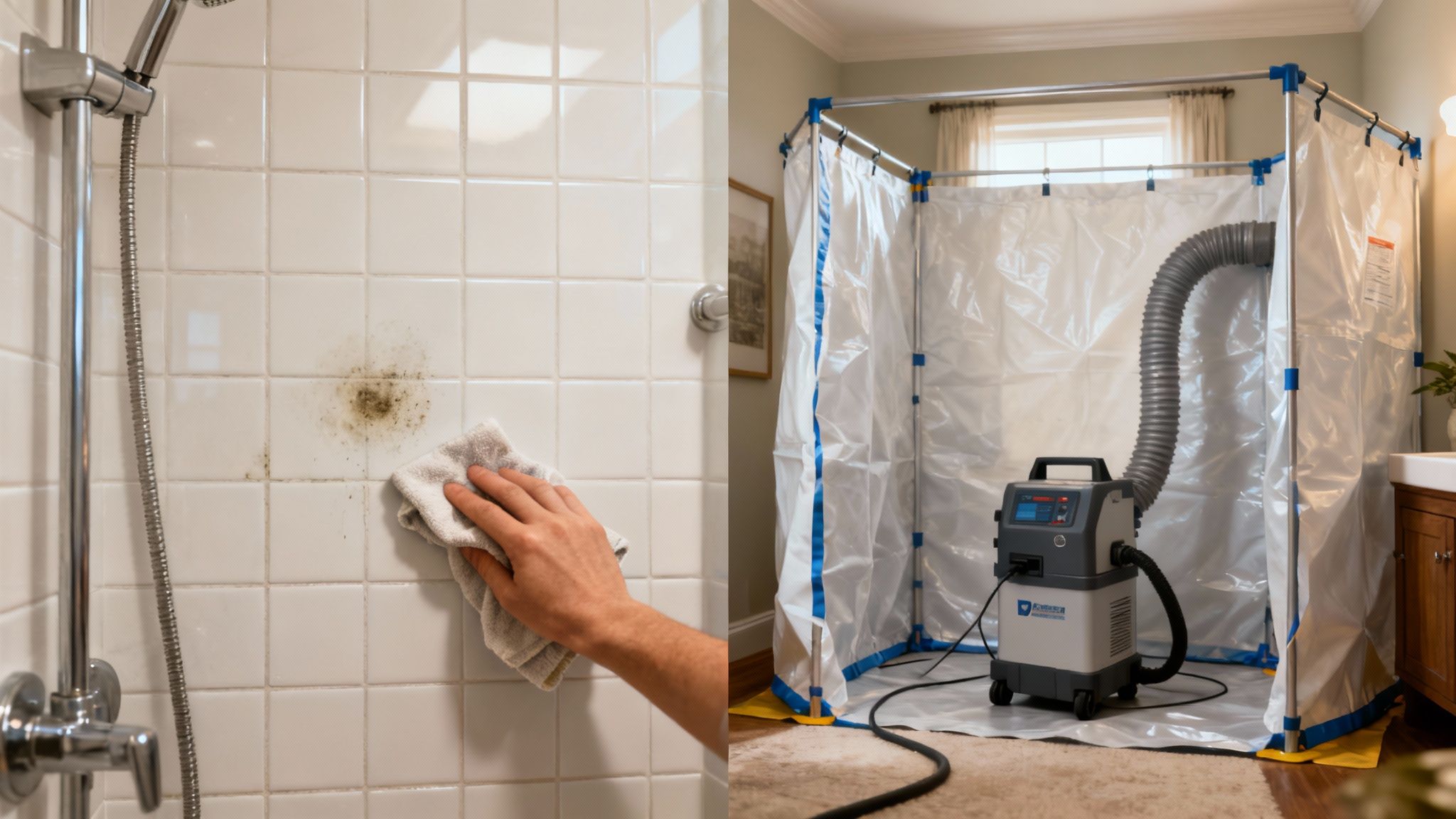
Think about that small patch of mildew you find on the shower tile. That’s a classic surface-level problem. Because tile isn’t porous, the mold is just sitting on top, and a good scrubbing is usually all it takes.
But when mold starts growing on something porous like drywall, wood, or the paper backing on your insulation, it’s a completely different ballgame. The mold isn’t just on the surface anymore; it has sent roots deep into the material, much like a weed in your garden. Simply wiping the top won’t get rid of the problem.
What Professional Remediation Actually Involves
This is where true professional remediation comes in, and it’s far more than just a deep clean. It’s a systematic process designed to completely remove the mold colony, deal with the airborne spores, and fix the moisture problem that started it all.
A real remediation job will always involve a few key steps:
- Containment: The first thing a pro does is seal off the entire area with heavy plastic sheeting and often negative air pressure. This creates a quarantine zone to stop microscopic spores from spreading through your HVAC system and contaminating the rest of your home.
- Air Filtration: They’ll bring in commercial-grade air scrubbers armed with HEPA filters. These machines run continuously throughout the project, literally pulling mold spores out of the air.
- Controlled Demolition: Infested materials that can’t be saved—like drywall, carpeting, or insulation—have to go. Professionals are trained to remove them carefully to minimize spore release.
- Deep Cleaning & Disinfection: Once the contaminated materials are out, every remaining surface in the containment zone (studs, subfloor, etc.) gets meticulously cleaned with antimicrobial agents.
- Fixing the Source: The most crucial step. A good remediation company will identify the leak, condensation, or humidity issue and ensure it’s addressed. Without this, the mold will come back.
This comprehensive approach is exactly why a mold removal cost calculator will show higher figures for remediation. You’re not paying for a cosmetic fix; you’re paying for a permanent solution.
Key Takeaway: Cleaning just wipes away what you can see. Remediation is a full-scale assault on the entire mold colony, its airborne spores, and the water source that feeds it. Anything less is just a temporary fix.
For those minor, surface-level issues I mentioned, a simple cleaning might be all you need. On non-porous surfaces, the average cost to clean visible mold is around $2.26 to $2.76 per square foot in ideal conditions. You can get more details on those specific cleaning costs from Homewyse.com. But remember, that number becomes irrelevant the moment mold has penetrated a material or covers a large area.
Mold Cleaning vs. Professional Remediation
It can be tough to decide which path to take. Here’s a quick comparison to help you see the differences more clearly.
| Feature | DIY Mold Cleaning | Professional Remediation |
|---|---|---|
| When It’s Appropriate | Small spots (under 10 sq ft) on non-porous surfaces like tile, glass, or metal. | Large infestations (over 10 sq ft), growth on porous materials (drywall, wood), hidden mold, or after water damage. |
| Process | Surface scrubbing, often with household cleaners like bleach or vinegar. | Full containment, air scrubbing, HEPA vacuuming, removal of contaminated materials, and antimicrobial treatment. |
| Long-Term Effectiveness | Low. If the moisture source isn’t fixed, regrowth is almost guaranteed. | High. Aims to permanently eliminate the mold colony and prevent its return by addressing the root cause. |
| Typical Cost Per Sq Ft | $2.26 – $2.76 (for surface cleaning only) | $10 – $25+ (depending on complexity and materials) |
Ultimately, choosing professional remediation is an investment. It protects the structural integrity of your home, its resale value, and most importantly, your family’s health. It’s the peace of mind that comes from knowing the problem has been solved for good.
Budgeting for Hidden Mold Remediation Costs
The first quote you get from a remediation company is just that—a starting point. It’s almost never the final number you’ll see on the invoice. To avoid getting blindsided by surprise expenses, you need to think beyond the cleanup itself. A realistic budget accounts for the entire process, from start to finish.
Too many people plug numbers into a mold removal cost calculator and only budget for the actual mold removal. But the total financial hit comes from a few different stages, and skipping any of them is a recipe for disaster. These aren’t just optional add-ons; they’re critical for making sure the mold is gone for good.
Pre-Remediation Essentials
Before a single wall is opened up, you often need a professional assessment. Let’s say you smell that distinct musty odor, but can’t see any visible mold. This is where you’d budget for initial mold testing. A professional will take air and surface samples to confirm not only that mold is present but also what type you’re dealing with.
This is especially critical when you suspect hidden mold behind walls. What you can’t see is often the biggest problem, and testing gives the remediation team the hard data they need to create an effective plan.
Post-Remediation Verification and Repairs
Once the remediation crew packs up, how can you be sure they actually got it all? That’s where post-remediation verification, or “clearance testing,” comes in. You’ll want to hire an independent third party to test the area and confirm the mold spore counts are back to normal, safe levels. It’s your proof that the job was done right.
Key Takeaway: The biggest budget-busters are almost always the reconstruction costs. The remediation team’s job is to tear out contaminated materials—drywall, insulation, flooring. Their job doesn’t include putting it all back together.
You’ll be on the hook for hiring contractors to rebuild walls, lay new floors, install cabinets, and repaint. On top of that, you have to fix whatever caused the mold in the first place. Whether it was a leaky pipe, a cracked foundation, or a faulty roof, ignoring the source of the moisture guarantees the mold will come right back. Factoring these repairs into your initial budget is the smartest thing you can do to turn a nightmare scenario into a manageable project.
FAQs About Mold Removal Costs
Here are answers to the most common questions we get about the cost of professional mold remediation.
Q: Does homeowners insurance cover mold removal in California?
A: It depends entirely on the cause. If the mold resulted from a “covered peril” like a sudden pipe burst, you’re likely covered. However, most standard policies in California specifically exclude mold damage from gradual issues like slow leaks, high humidity, or lack of maintenance. Always check your specific policy or call your agent.
Q: Do I need to pay for professional mold testing first?
A: Not always. If the mold is visible and covers less than 10 square feet, testing is often unnecessary. Focus on safe removal and fixing the moisture source. However, testing is crucial if you suspect hidden mold (e.g., you smell it but can’t see it), are involved in a real estate transaction, or have health concerns that could be linked to mold exposure.
Q: Can I clean black mold myself to save money?
A: For a very small, contained spot on a non-porous surface, maybe. But for anything larger or on materials like drywall, DIY is risky. Improper cleaning can release millions of toxic spores into the air, turning a localized issue into a whole-house problem. Professionals use containment and air filtration to prevent this.
Q: How long does a mold remediation project take?
A: The timeline depends on the scope. A small, accessible job (like under a sink) might take 1-3 days. A major project in a basement or attic, involving significant demolition and drying, could easily take a week or more.
Q: What should I do if I find mold behind drywall?
A: Immediately stop using the area to avoid disturbing the mold and contact a licensed restoration company. Do not attempt to cut into the drywall yourself. Mold often spreads far beyond the visible spots, and a professional assessment is needed to determine the extent of the contamination and the safest removal plan.
If you’re staring down a mold problem and need a clear, professional opinion, Onsite Pro Restoration is here to help. Our IICRC-certified technicians serve the Los Angeles area, providing honest assessments and expert mold remediation.


